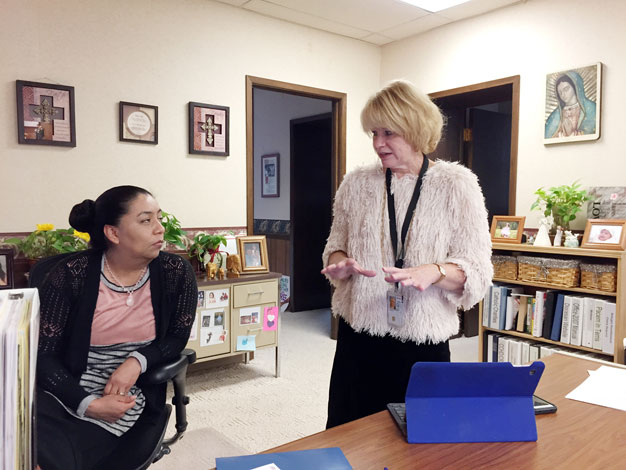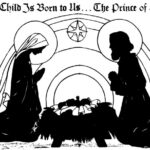
Shelby Newberry, a partnership specialist with the Department of Commerce’s U.S. Census Bureau, discusses promotional efforts with Esmeralda Guerrero, administrative assistant in the Diocese of Davenport’s Social Action office. Newberry, a member of Sacred Heart Cathedral in Davenport, spoke with a group of diocesan representatives last month about taking a leadership role in promoting the 2020 Census in the diocese’s 22 counties.
By Barb Arland-Fye
The Catholic Messenger
This year kicks off with a massive effort to promote participation in the 2020 Census in our parishes, neighborhoods, towns and cities across the nation. Everybody matters in this once in a decade survey of the U.S. population that determines representation in Congress, allocation of funds for new roads, schools and emergency services, social services, housing construction and business decisions.
The U.S. Census Bureau also recognizes the challenge that exists in counting every woman, man and child in an increasingly global, mobile environment. To overcome the challenge, the U.S. Census Bureau is mobilizing Complete Count Committees, launching social media and advertising campaigns and introducing three options for responding: online, by phone or by mail.
In mid-March, the Census Bureau will send an invitation in the mail to households inviting them to respond online to the 2020 Census. Some households will also receive paper questionnaires, particularly in areas that are less likely to respond online. Expect to receive a reminder letter March 16-24.
From March 26-April 3, the Census Bureau will send a reminder postcard to those who have not yet responded to the survey, which asks basic, easy-to-complete questions. A reminder letter and paper questionnaire will arrive in the mail April 8-16 and a final reminder postcard April 20-27. All responses are confidential.
Those who have not responded by the end of April will receive a visit from a Census worker to complete the survey, said Shelby Newberry, a partnership specialist with the Department of Commerce’s U.S. Census Bureau. A member of Sacred Heart Cathedral in Davenport, she spoke with a group from the Diocese of Davenport about taking a leadership role in promoting the 2020 Census in the diocese’s 22 counties.
The Census Bureau reports that an estimated 5 percent of children younger than 5 years old (approximately 1 million young children) were not counted in the 2010 Census, the highest of any age group. These kids did not make the count for a variety of reasons, including, splitting time between two homes; living in a lower-income household; living in a household with young parents or a young, single mom; or the child was a newborn. This information is crucial in providing services that affect young children and their families.
“The census count is very important to all of us. It is most important that everyone is counted,” Bishop Thomas Zinkula said in an email to pastors, parishes and other entities. “Data collected helps direct the amount of federal funding flowing into our cities for programs like Medicare and Medicaid, Head Start, free and reduced school lunches, and road construction and repair. It determines the amount of Title 1 funding to assist disadvantaged children. It also plays a role in Pell Grants that help older students pay for college. The data is completely confidential. Names and addresses cannot, by law, be released for 72 years after the information is collected. A census postcard will arrive at your residence, don’t ignore it. Be counted.”
Bishop Zinkula designated Loxi Hopkins, a volunteer in the Diocese of Davenport’s Social Action Office, to coordinate the diocese’s efforts to ensure that the people of the diocese participate in the 2020 Census. “So much funding that comes into our community is dependent on counting everyone,” Hopkins said. “Money for education, housing and many other things are dependent on accurate numbers.”
The impact of U.S. Census data
By Glenn Leach
For The Catholic Messenger
U.S. Census data provides a statistical profile of our communities. These numbers determine:
The number of members of the House of Representatives and state legislators to represent us.
The area of legislative districts.
Allocation of $675 billion dollars in federal programs to various communities across the country.
Under-representation in the 2020 Census survey could result in lost federal dollars and harm to existing programs, such as:
Medicaid
Medicare Part B Physicians Fee Schedule
Supplemental Nutrition Assistance Program
Highway Planning and construction
Federal Pell Grant Program
National School Lunch Program
Temporary assistance for Needy Families
Section 8 Housing choice vouchers
Title 1 Grants to local education Agencies
Special Education Grants to States
State Children’s Health Insurance Programs
Head Start/Early Start
In addition to federal programs and dollars:
Companies use Census data to help select locations to build or expand services.
Businesses use Census data to help determine what products to manufacture and location of potential markets.
Real estate and construction firms use Census data to determine housing market and business growth potential.
Various organizations use Census data to set rates that people pay for different services.
Entertainment (music, recreation, travel) and publishing organizations use the data to assess what audiences may exist, their size, and relative wealth for their products.
Utilities use Census data for planning purposes, including access to high-speed internet service.
Census data also provides more accurate estimates of the size and growth of particular groups within the overall population.
What the U.S. Census asks and why
The designated person in your household – yourself or someone else – will complete the following questions in the 2020 Census:
Number of people living or staying in the household. This question relates to overall population and its effect on determining congressional representation and the drawing of boundaries for congressional districts, state legislative districts and school districts.
Any additional people living or staying in the household. This question aims to avoid duplication in the count.
Owner/renter. Homeownership rates serve as an indicator of the nation’s economy and help in administering housing programs and with planning decisions.
Phone number. The Census Bureau asks this question in case it needs to contact the respondent and will never share the phone number.
Name. List the names of each person in the household to ensure that the Census Bureau gets an accurate count for the 2020 Census.
Sex. The Census Bureau asks this question to create statistics about males and females. Such data helps determine the planning and funding of government programs and evaluates government programs and policies for fairness and equability.
Age and date of birth. The Census Bureau depends on these statistics to understand the size and characteristics of different age groups. Local, state, tribal and federal agencies use the data to plan and fund government programs that provide assistance for special age groups, such as children, working-age adults, women of childbearing age and older populations.
Hispanic, Latino or Spanish origin. The data collected creates statistics about this group and assists federal agencies in monitoring compliance and antidiscrimination provisions, such as under the Voting Rights Act and the Civil Rights Act.
Race. Federal agencies use the data in monitoring compliance and antidiscrimination provisions, such as under the Voting Rights Act and the Civil Rights Act. State governments use the data to determine congressional, state and local voting districts.
Whether a person lives somewhere else. This question responds to the Census Bureau’s goal of counting people once and only once.
Relationship. This question addresses the relationship of each person in a household to the central person to create estimates about families, households and other groups. The information helps with planning and funding of government programs that provide funds or services for families, people living or raising children alone, grandparents living with grandchildren or households that qualify for additional assistance.
For more information, visit the website 2020CENSUS.GOV
—Source: U.S. Census 2020











